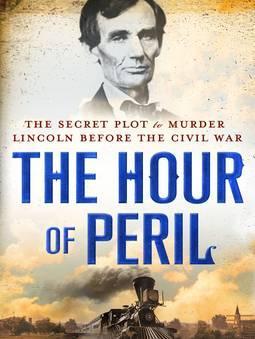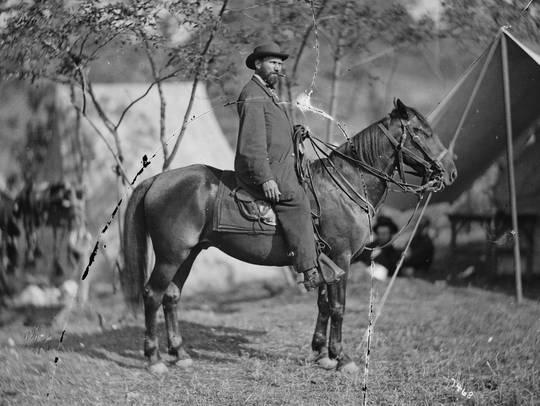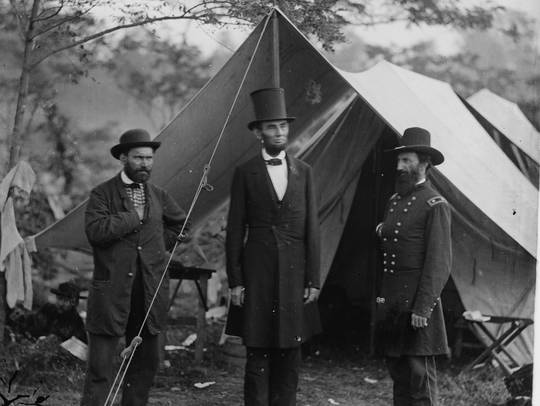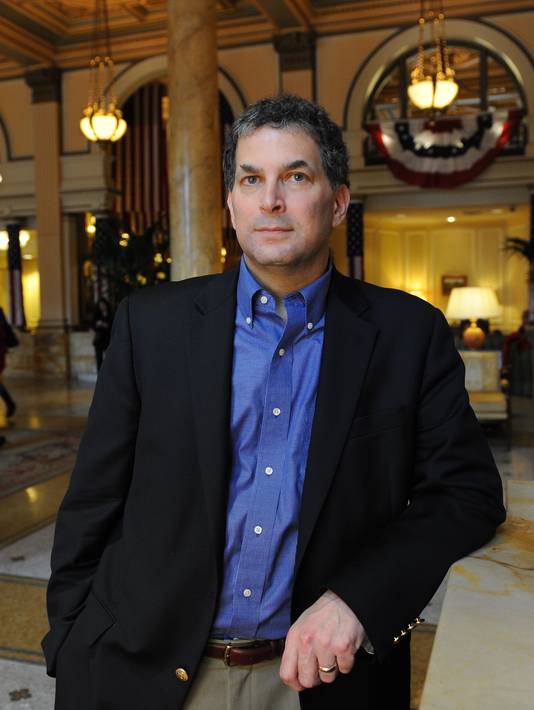WASHINGTON — Bill O’Reilly, you’ve got company.
O’Reilly’s 2011 book Killing Lincoln: The Shocking Assassination That Changed America Forever has been a monster best seller.
Now, a new book about the first time would-be assassins tried killing Lincoln is hitting shelves. Daniel Stashower’sThe Hour of Peril: The Secret Plot to Murder Lincoln Before the Civil War (Minotaur) describes a shocking but little-remembered assassination conspiracy called the “Baltimore Plot” that could have utterly changed the course of American history.
As we all now know, the “Baltimore Plot” failed. Which is why president-elect Abraham Lincoln could walk into Willard’s Hotel on the morning of Feb. 23, 1861 — nine days before his inauguration on March 4 — and ask to borrow a pair of slippers from the proprietor, Henry Willard.
On a recent morning, Stashower sits on a velvet couch amid the ornate splendor of the restored and rebuilt Willard Hotel, where Lincoln, as president-elect, once occupied a five-room suite overlooking the White House. Massive American flags hang in the halls. Outside on Pennsylvania Avenue, bleachers are being erected for the upcoming second inauguration of President Obama.
FIND MORE ON BOOKISH: Essential books on Abraham Lincoln[1]
Stashower, 52, has spent years obsessing about the days leading up to an earlier inauguration, the one in 1861 as the nation lay shattered and divided. But when he imagines Lincoln entering Willard’s Hotel (its original name), Stashower doesn’t focus on the 16th president. Rather, his mind’s eye is drawn to the sharp-eyed, ginger-haired man who was at Lincoln’s side that day.
Meet Allan Pinkerton, the star of The Hour of Peril. The Scottish immigrant headed up the team of detectives that kept Lincoln safe during the two-week train ride that began on Feb. 11 in Springfield, Ill., and ended Feb. 23 in Washington.

‘The Hour of Peril’ is about the first time would-be assassins tried killing Lincoln.(Photo: AP)
The “hour of peril” occurred in Maryland, then a slave state. A group of conspirators led by an Italian barber named Cypriano Ferrandini planned to stab Lincoln to death as he changed trains in Baltimore. To thwart them, Pinkerton arranged to smuggle Lincoln into Washington ahead of the published schedule, in disguise and in secret. Among the detectives was America’s first female private eye, a 23-year-old widow named Kate Warne.
Stashower brings a unique perspective to the story of the first attempt to assassinate Lincoln. He’s not a historian fixated on Civil War battles and American politics. Rather, the Bethesda, Md.-based writer been obsessed with detectives, clues, plots and whodunits since he was an 11-year-old wearing a deer stalker hat in honor of his hero, Sherlock Holmes. The author of non-fiction books including an award-winning bio of Arthur Conan Doyle, Stashower also has written mystery novels. Several of his mysteries feature Harry Houdini.
Stashower’s publisher has high hopes for The Hour of Peril. “I love narrative non-fiction, non-fiction that reads like a novel,” says Andrew Martin of Minotaur. He compares Peril to fast-paced best sellers mixing history and crime such as Erik Larson’s The Devil in the White City. Stashower’s book is the first non-fiction that Minotaur, which specializes in mysteries and thrillers, has ever published.
Martin signed up Stashower four years ago, before O’Reilly’s book. “We didn’t buy this book because of Lincoln,” says Martin. “We bought it because it had all the right elements. Here is Allan Pinkerton at a critical moment in American history — Lincoln’s train ride right on the brink of the Civil War — and the first private eye in the United States hires the first female detective!”
To say Lincoln is a popular subject is an understatement. “You could build a bridge to Springfield with all the books written about Lincoln,” Stashower says. In fact, there have been more than 16,000 books published on Lincoln since 1865, making him the most written-about president.
And interest in Lincoln remains high. For evidence, look at Steven Spielberg’s hit film, with 12 Oscar nominations. The Hour of Peril is also an Indie Next pick recommended by independent booksellers. Civil War historian James McPherson gave the book a blurb, writing that it “reads like a first-class detective story.”

Allan Pinkerton on horseback in 1861. The Scottish immigrant headed up the team of detectives that kept Lincoln safe during the two-week train ride.(Photo: Library of Congress)
Peril opens with extraordinary drama. In a nation where seven states had already seceded, Lincoln’s journey by rail was an opportunity for frightened citizens “to see him, to hear his voice,” says Stashower. Half a million people would see Lincoln as he traveled, stopping in cities like Indianapolis, Cincinnati, Columbus, Pittsburgh, Cleveland, New York and Philadelphia.
Stashower points out that joining the president-elect aboard the “Lincoln Special” was very different from what Acela riders experience today. In 1861, railroads were privately owned with tracks stopping and starting. “Imagine a handful of spaghetti dropped on a map,” Stashower says. The “Lincoln Special” would travel more than 2,000 miles on 18 different railroad lines. A breakneck speed would be 30 mph.
Some elements of the book are hilarious. Lincoln’s oldest son, Robert, lost the carpetbag containing the working version of the inaugural address. His horrified father dug the satchel out of a pile of hotel luggage. The enthusiastic crowds pushed so violently to see Lincoln that, in Buffalo, Lincoln’s aide Major Hunter had his shoulder dislocated.
But many Lincoln supporters were worried about the reception the new president would receive in hostile Maryland. Hearing rumors of assassination plots, Lincoln’s future Secretary of State William Henry Seward sent his son to warn the incoming president. Stashower says there were several possible scenarios — bridges blown up or a bomb placed on Lincoln’s train.
Pinkerton — already a famous detective whose clients included many railroad companies — most feared the “Baltimore Plot,” of Lincoln being surrounded by a crowd and stabbed.
After Pinkerton and Seward’s son convinced Lincoln that his life was in danger, he agreed to slip out of Harrisburg, Pa., first by carriage, then by train, accompanied only by his best friend, Ward Lamon, and Pinkerton.

Allan Pinkerton and Abraham Lincoln, with General John A. McClernand, at Antietam, Maryland, October 3, 1862.(Photo: Library of Congress)
Pinkerton’s plan to protect Lincoln involved thwarting possible assassins by bringing Lincoln through Baltimore hours ahead of the published itinerary of the “Lincoln Special.” It also included a ruse with Warne. At the Philadelphia train station, the detective greeted the shawl-wrapped Lincoln as though he were her invalid brother. Then she escorted Lincoln into an unlocked sleeping compartment she’d reserved ahead of time.
Little is known of Warne before she appeared in Pinkerton’s Chicago office in 1856 asking for a job, arguing “a female detective may go and worm out secrets in ways that are impossible for male detectives.” Stashower marvels that she was hired “decades before there were female police officers.”
Though the film rights to The Hour of Peril haven’t been sold yet, Stashower has already cast the heroine: Laura Linney.
Pinkerton’s plan succeeded in keeping Lincoln alive but it damaged the new president’s image. “It turned into a public relations disaster,” says Stashower. Lincoln himself reportedly noted, “What would the nation think of its President stealing into the Capital like a thief in the night?”
History buffs might recall a contemptuous Harper’s Weekly cartoon titled “The Flight of Abraham,” which portrayed Lincoln in a silly-looking tam-o-shanter hat with ribbons. “People are still arguing over what he had on his head,” says Stashower.
The “Baltimore Plot” also remains a source of historical argument. Pinkerton and Lamon became bitter enemies, fighting for decades about what really happened and the severity of the threat. The supposed Baltimore ringleader Ferrandini was never arrested. “The trail goes cold there,” Stashower admits.
And what happened to Warne? She died at 35 with Pinkerton at her bedside. Along with several other agents, Warne is buried in the Pinkerton family plot in Chicago. Stashower doesn’t speculate about a possible romance between the married Pinkerton and the woman he called “Mrs. Warne.”
But we do know Pinkerton’s response to the events of April 14,1865. According to his son, the detective wept bitterly upon hearing that another plot to kill Lincoln had succeeded, thanks to John Wilkes Booth, born and bred in Maryland.
“If only I had been there to protect him as I had done before,” Pinkerton declares in the final pages of The Hour of Peril.
References
- ^ http://blog.bookish.com/essential-books-on-abraham-lincoln (blog.bookish.com)
